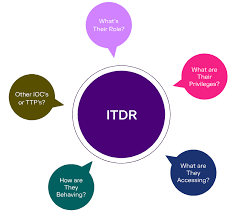In today’s interconnected digital ecosystem, the protection of identities has become a critical priority for organizations worldwide. As cyberattacks evolve in sophistication, identity-based threats such as account takeovers, credential stuffing, phishing, and insider misuse have emerged as key attack vectors. Traditional security tools often fall short when it comes to recognizing and responding to these identity-driven risks. This is where Identity Threat Detection and Response (ITDR) comes into play, offering a focused framework to protect digital identities and ensure secure access across enterprise environments.
Identity Threat Detection and Response (ITDR) refers to a set of tools, practices, and strategies designed to detect, investigate, and mitigate identity-based threats across digital systems. Unlike conventional cybersecurity measures that primarily focus on endpoints or network perimeters, ITDR zeroes in on safeguarding identity systems, including user accounts, privileged credentials, and authentication mechanisms. The approach emphasizes proactive monitoring of suspicious activities related to identities and responding swiftly before they escalate into data breaches or large-scale security incidents.
One of the driving factors behind the rise of ITDR is the shift toward cloud adoption, remote work, and digital transformation. As businesses migrate workloads to the cloud and embrace distributed teams, the number of identities—human, machine, and application—has multiplied significantly. Each of these identities represents a potential entry point for attackers. Cybercriminals exploit weak or stolen credentials to infiltrate enterprise systems, bypassing traditional defenses. ITDR helps organizations address these vulnerabilities by offering visibility into identity behavior, detecting anomalies, and applying contextual intelligence to prevent misuse.
The core functionality of ITDR lies in its ability to integrate real-time monitoring with behavioral analytics. By leveraging artificial intelligence and machine learning, ITDR solutions can establish baseline patterns of normal identity behavior and flag deviations that may signal malicious intent. For example, unusual login attempts from unfamiliar geolocations, unauthorized privilege escalations, or abnormal access to sensitive data can trigger alerts for further investigation. In addition, ITDR solutions provide forensic capabilities, allowing security teams to analyze past identity-related activities and uncover hidden attack paths.
A significant advantage of ITDR is its synergy with other cybersecurity solutions such as Identity and Access Management (IAM), Privileged Access Management (PAM), and Security Information and Event Management (SIEM). While IAM ensures secure access provisioning and PAM controls high-level privileges, ITDR adds an intelligence layer that continuously monitors for identity-related anomalies. This layered defense strategy enhances the overall resilience of organizations against identity-centric threats, ensuring that even if attackers bypass preventive measures, they can still be detected and neutralized in real-time.
The growing emphasis on regulatory compliance also underscores the need for ITDR. Data protection laws such as GDPR, HIPAA, and CCPA require organizations to safeguard personal data and prevent unauthorized access. Identity-related breaches not only cause financial loss but also invite severe regulatory penalties and reputational damage. By adopting ITDR solutions, businesses can demonstrate compliance readiness while minimizing risks to sensitive information.
Source - https://www.marketresearchfuture.com/reports/identity-threat-detection-response-market-22216
Identity Threat Detection and Response is emerging as a vital pillar of modern cybersecurity strategies. As digital identities become the new perimeter, organizations must prioritize ITDR to counter increasingly sophisticated identity-based attacks. By combining continuous monitoring, advanced analytics, and rapid response mechanisms, ITDR empowers enterprises to safeguard user identities, secure critical assets, and maintain trust in an era of relentless cyber threats.



